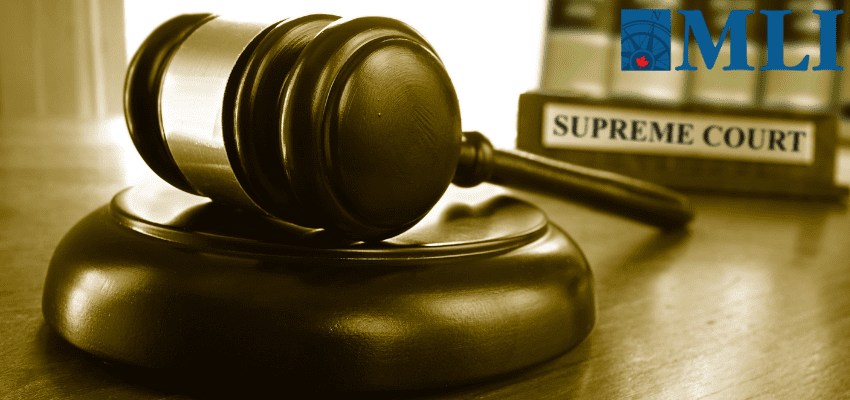This article was originally published by the National Post
By Stéphane Sérafin and Kerry Sun, October 9, 2024
There is a growing sense in Canada that our judges, and especially those on the country’s highest court, routinely overstep the boundaries of their office. Until last week, however, one might have thought that support for this conclusion could only be inferred from the Supreme Court of Canada’s judgments. That changed on Wednesday, when recent public remarks by the Chief Justice of Canada, Richard Wagner, sent shockwaves through social media.
At a press conference on June 3, Chief Justice Wagner was asked to comment on an ongoing controversy over whether the Supreme Court should provide official French-language translations of its judgments prior to 1970, before the Official Languages Act was enacted. Attempting to justify the court’s refusal to do so, he made a series of bizarre claims that sought to diminish the importance of his own court’s prior decisions.
According to Wagner, “apart from considering these decisions as part of our legal cultural heritage, no one today will refer to a decision from 1892 to support his claim,” later adding that “sometimes a decision from five years ago is an old decision, in commercial and civil matters.” He then concluded that “the legal value of these historical decisions is quite minimal.”
Coming from Canada’s top judge, these cavalier statements reflect a breathtaking dismissal of the role and significance of legal precedent. As any practicing lawyer will readily attest, at all levels of court across Canada, litigants routinely cite and rely upon judgments of the Supreme Court dating back much further than the 1970s. This is most apparent in the Canadian provinces and territories other than Quebec, where basic areas of law — the law of contracts, torts and property, for instance — are founded upon the common law, which emerges from legal precedents and landmark decisions that date back centuries. It is also true across the country where fundamental issues of constitutional law are concerned, including in matters relating to the division of powers between the federal and provincial governments. Here, precedents dating back to 1892 and beyond continue to be authoritative.
What is even more troubling about the chief justice’s remarks, however, is that they confirm the now widespread impression of an undisciplined approach to judicial responsibility at the Supreme Court of Canada. Regrettably, the judicial decisions that appear to exemplify this attitude are legion. Rather than attempting to resolve disputes within settled legal frameworks and principles, recent appeals before the court are explicitly framed as invitations to overturn established doctrine. This was notably the case in Canada v. Bedford (2013) and Canada v. Carter (2015), two Charter challenges that targeted the criminal prohibitions on prostitution-related activities and assisted suicide, respectively. In ultimately deciding to strike down these laws, the Supreme Court went so far as to approve the effacement of its prior work.
More recently, in a case where a claimant sought compensation from the public purse for the mere enactment — as opposed to the enforcement — of a law later deemed to be unconstitutional, the Supreme Court again emancipated itself from the constraints of settled law. Under orthodox constitutional principles, inherited from the United Kingdom, the recourse for imprudent legislation is found in the democratic process, not in the courts. Yet the majority judgment in Canada v. Power (2024), co-authored by Chief Justice Wagner, effectively embraced judicial supervision over the law-making process, unperturbed by its drastic departure from longstanding constitutional tradition. In the court’s eyes, the Charter had effected a “revolutionary transformation of the Canadian polity” in 1982, such that courts now had a right and duty to sit in judgment over Parliament and legislative decision-making.
This image of the Charter as a revolutionary device explains much of the chief justice’s attitude toward Canada’s “legal cultural heritage.” According to this view, all decisions prior to the Charter’s enactment in 1982 have little value to the law, as he put it. Even the Supreme Court’s early decisions on the Charter could conceivably be regarded in the same way, namely, as outmoded historical relics.
These judicial statements bring forth a key question: What, after all, is the task of judging according to law, if not to reason through and adjudicate disputes using the intellectual resources of our legal heritage? For Wagner, the judicial role does not involve being constrained and guided by established legal authority, much less working to resolve disputes with an aim to developing legal doctrine on which future court decisions can rely. Rather, he seems to imply that the judges on his bench are empowered to make and remake the law as they see fit, in a way that befits a legislature, not a court. The true centre of public power in Ottawa is not Parliament, but the Supreme Court.
This conclusion is disturbing, quite apart from how one feels about translating the Supreme Court’s pre-1970 judgments. In conjecturing that Canada’s legal heritage has little value, the chief justice strikes at the very heart of the rule of law and envisages an unchecked judicial power. It is ironic that his annual press conference, itself an innovation ostensibly designed to improve the public’s confidence in the judiciary, should have precisely the opposite effect.
Our legal heritage is not a mere relic, fit for display only. Settled legal principles and the precedents that illustrate them are crucial to the proper exercise of judicial power. Canadians would do well to heed Chief Justice Wagner’s candid remarks, which invite all of us to question how judicial responsibility is discharged at the apex of our legal system.
Stéphane Sérafin is a Senior Fellow at the Macdonald-Laurier Institute and Assistant Professor in the Common Law Section, Faculty of Law, University of Ottawa.
Kerry Sun is a doctoral student at Merton College, Oxford and Fortescue Scholar with the Canterbury Institute.






